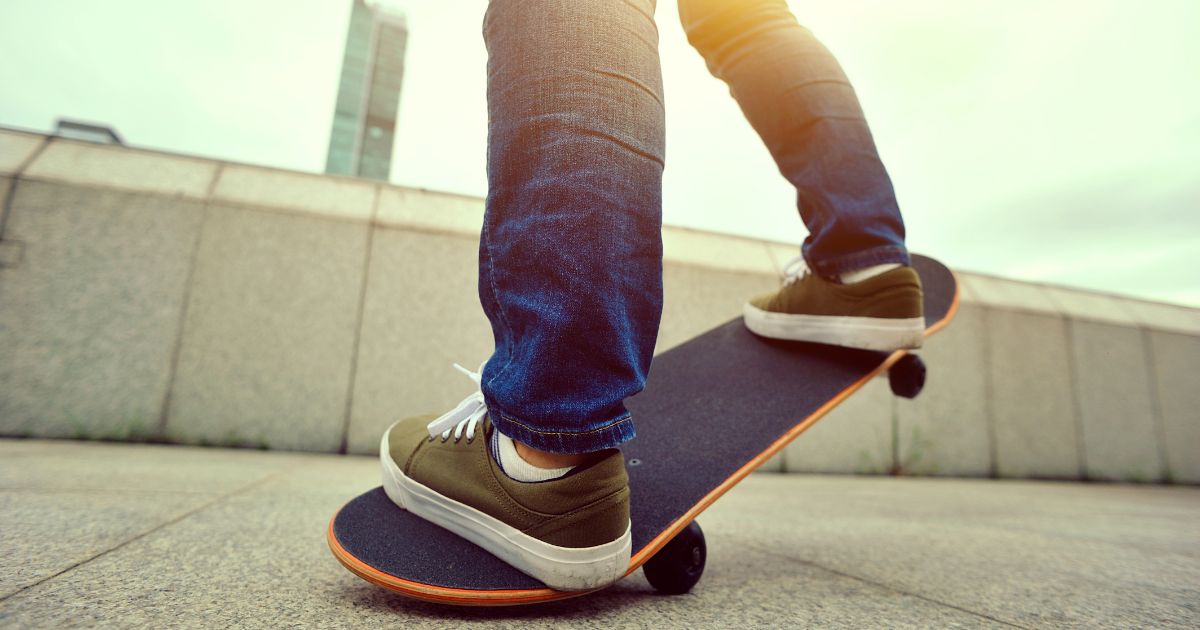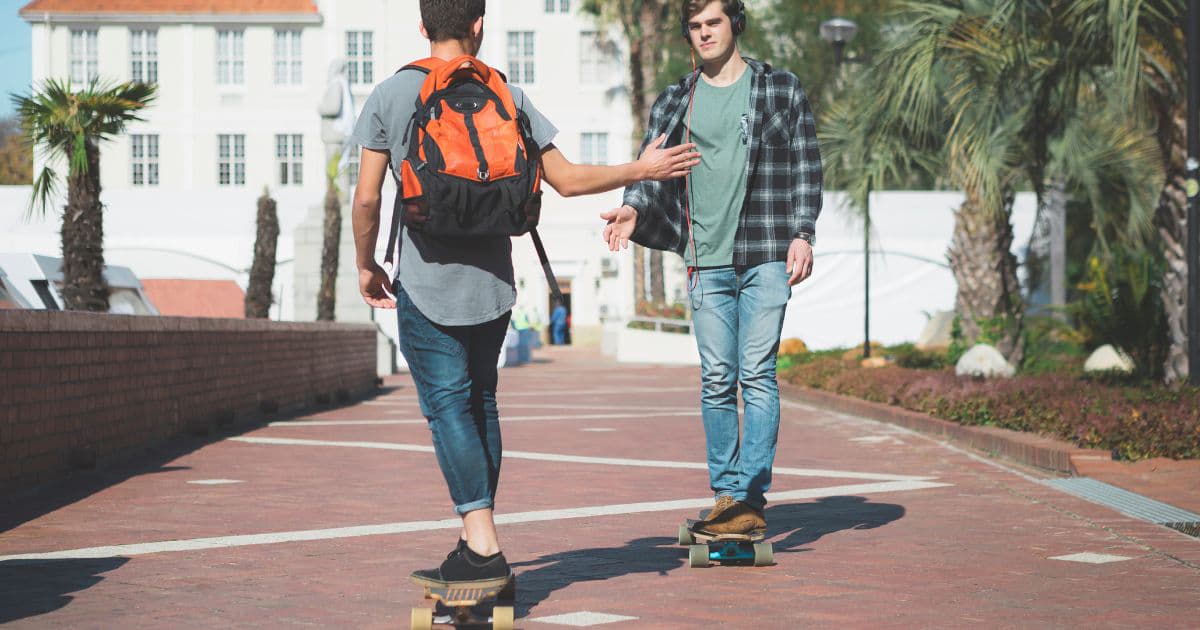As a beginner skateboarder, you’ll first learn about maintaining balance on the deck then you’ll push your feet on the ground to move forward. However, it is also important to learn how to slow down on a skateboard so you can safely maneuver the board at high speeds.
In this guide, we detail six of the best braking techniques on a skateboard plus expert tips on reducing speed wobbling.
How to Slow Down on a Skateboard
There are several different techniques to slow down when you’re moving at high speeds on a skateboard. Here are six of the best ones to learn as a beginner. We also detail a few pros and cons of each technique.
Back Foot Deceleration Technique
An all-rounder method for braking speed on a skateboard, the back foot deceleration technique is what most beginners already do on instinct. Here’s how to practice it safely:
- On a relatively large hill, take your preferred stance on the skateboard.
- Push forward using the back foot and carefully lower your body while maintaining balance and making sure most of your weight is on the front truck.
- Slowly take the back foot off the deck and skid it on the ground placing extra pressure to control the braking power.
The only disadvantage of the back foot deceleration technique is that it damages the soles of the shoes.
The Frontside Powerslide Technique
A cool braking technique that is sure to impress everyone is the frontside powerslide technique. It is a bit more advanced but quite reliable. Here’s how to do it:
- On a flat and paved surface, push forward on the skateboard and gain speed.
- Bend your knees and carefully move your back foot to the tail of the deck so that your toes are over the truck.
- Place your front foot over the front truck so that your weight is balanced on the shoe’s sole.
- Apply pressure on the front foot and carefully turn the board to a horizontal position using the back foot to push the board forward.
The frontside powerslide technique doesn’t ruin your shoe’s sole or the deck. However, the wheels of the skateboard will gradually get smaller.
The Controlled Slide Technique
Perfect for downhill riding, the controlled slide technique is a great choice for quick stops at high speeds. Here’s how to do it:
- On a small slope, place your front foot over the front bolts or trucks of the skateboard so that it’s facing the board’s nose.
- Bend your knees or lower your stance and then carefully use your front foot as a turning axis while using your upper body to pivot.
- Drift to a stop and place your hands on the road for a quick and more stable stop.
Make sure to wear gloves while practicing the controlled slide technique to prevent road rash.
The Hand Power Slide Technique
Particularly great for longboarders as well as skateboarders, the hand powerslide technique is great for ensuring stability while braking. Here’s how to do it:
- Take your preferred stance and push the skateboard forward on a smooth road.
- Once it gains speed, crouch down and lean forward so your weight is mostly on the front truck.
- Carefully apply pressure to your front foot and then place your hands on the road to skid to a stop.
Make sure you’re wearing abrasion-resistant gloves while doing the hand powerslide technique.
The Tail Scraping Technique
Great for stopping the skateboard at slow speeds, the tail scraping technique is easy to learn. Here’s how to do it:
- On a sidewalk, take your preferred stance and gently push forward so that your front foot is in the middle of the deck.
- Place your back foot on the tail of the board, lean forward, and apply pressure until the back of the deck hits the ground.
- Once you hear a scraping sound, the board will start to slow down.
Make sure to practice the tail scraping technique in a low-traffic area. This method is a great starting point but it’s not as reliable as other methods because it’s quite easy to lose control of the board.
The Heel Scraping Technique
An easier alternative to the tail scraping technique, the heel scraping technique is similar to the former’s method however, this time, your back foot is placed at the end of the tail so that your heel makes contact with the ground and skids the skateboard to a stop on paved roads.
Expert Tips to Slow Down a Skateboard Without Wobbling
Speed wobbling is when the front and back of the skateboard are mismatched – i.e the back turns before the front trucks or the back trucks move haphazardly while the front moves straight.
It is one of the many reasons why skateboarders lose their balance on the deck and fall before there’s time to safely brake at high speeds. So, it’s important to know how to deal with wobbles on a skateboard. Here are some tips.
Check the Trucks
If the skateboard is wobbling at high speeds or turning sideways while you push straight, it’s usually because the trucks are loose or unevenly tightened. If the trucks are loose, the speed of the skateboard is going to be hard to control. Simply tighten the trucks before setting off.
Restricting movement on the front truck can increase the chances of speed wobbling, so make sure both trucks are evenly tightened or the back truck is tighter.
Steer from the Front
Always make sure your feet are placed farther forward than backward. This reduces the weight on the back truck and balances most of your weight on the front so steering is almost intuitive. Each foot should be at least shoulders’ width apart.
Similar to steering a car, a skateboard is ridden by maneuvering the front trucks so that at least 60% of your weight is placed forward.
Relax the Legs
When learning how to balance your feet on a skateboard, the key is to keep your legs relaxed and your knees bent. This way the weight of the body is distributed evenly and the upper body is tightened so it naturally leans forward. So, steering the skateboard and maintaining stability is easier at high speeds and the technique is more reliable.
Frequently Asked Questions
Do you push the skateboard with the front or back foot?
The skateboard is generally pushed with the back foot. It could be left or right, depending on what stance you choose to practice on the skateboard. If you naturally place your left foot on the deck and push with your right foot, you’re a regular rider. However, if you feel more confident pushing with your left foot while the right foot is on deck, then that is fine too.
Why does my skateboard go right when I push?
If your skateboard turns right while you’re pushing straight, it’s most likely because the bushings are crushed. Make sure you aren’t turning front-side or back-side while pushing forward to gain speed and if the matter persists, then swap the trucks around and this will even out the hardware.
How do you control a skateboard?
There are several different ways to control, steer and brake a skateboard but generally, it is recommended to understand which stance you feel most comfortable in – whether it’s pushing with your right or left foot. Then, carefully start riding and learn how to slow down as you go.
How healthy is skateboarding?
Skateboarding is quite a healthy sport and according to sports scientists, it’s a complete workout. It teaches balance and motor coordination, improves reflexes, builds muscle strength, and increases patience. Also, it works the cardiovascular system – i.e gets the blood pumping.
Is it normal to be sore after skateboarding?
Yes, it is normal to be sore after skateboarding. Whether you’re practicing for three hours a day or six, the board-based sport works the quads, glutes, back, and even the abs, so by the end of it, you’re most likely to be drenched in sweat with the legs that feel like jelly.
Is it okay to jump off the skateboard?
Yes, it is okay to jump off a skateboard. Most beginners instinctively do this because they master speed before learning how to slow down. Braking by jumping off the skateboard is effective, but it isn’t always pretty. Make sure to wear a helmet and keep your limbs loose before jumping off. Tight or stressed limbs increase the risk of injury.
Final Thoughts
Now that you know how to slow down on a skateboard, it’s time to get the board out and race forward while keeping your balance in check and maintaining confidence on rough roads and tough ramps. Don’t forget to wear a helmet because you’re preparing for the slide as much as the ride.


